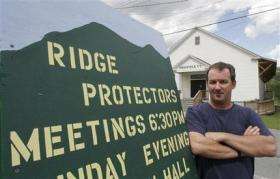Wind power a vexing question for Vermont

(AP) -- When farmer Greg Bryant first heard about plans for windmills along a swath of mountain ridges in this northeastern Vermont hamlet, he was all for it. The idea of tapping a plentiful natural resource for power was appealing.
Now he's dead set against it, one of many people here who fear the prospect of 400-foot tall windmills sprouting from the tops of picturesque mountains.
For a state that normally prizes environmental initiatives, the debate over wind power poses a thorny dilemma. Eager to embrace clean energy but leery about spoiling views, some communities are putting up stiff opposition to plans for new wind projects.
"It's a reflection of the deep environmental consciousness of this state," said environmentalist Bill McKibben, an author who has written about global warming. "People are rightly deeply attached to their landscape and they've done a terrific job in protecting it over the years."
In the 1930s, Vermonters rejected plans to build a parkway across the top of the Green Mountains, similar to the Blue Ridge Parkway in Virginia, that was intended to create jobs and draw tourists. In the 1960s, the state was so concerned about its mountain vistas that it banned billboards, and later passed a landmark development review law to preserve ridge lines as Vermont's ski industry began expanding its resorts.
"One of Vermont's most deeply held environmental ethics is the protection and preservation of our mountaintops and ridge lines," said Jason Gibbs, a spokesman for Gov. Jim Douglas. "While the governor supports renewable energy ... he cannot support the commercialization and industrialization of our mountaintops."
Environmentalists say that stance is unrealistic. They say large-scale wind towers must be part of the mix as the state seeks renewable energy alternatives in an age of global warming and rising fuel prices.
They also say the state needs to prepare for a future possibly without its two largest power sources.
Vermont now gets about a third of its power from the provincial utility Hydro-Quebec, and another third from the Vermont Yankee nuclear plant, but the contracts on both are due to expire within the next decade.
"For us to say we don't want wind turbines in Vermont is irresponsible," said James Moore, an environmental advocate with the Vermont Public Interest Research Group. "If not wind, are we going to be supporting coal and mountain top removal? Are we going to support oil and aging nuclear power plants and nuclear waste?"
About 30 states have wind farms capable of producing enough power to be sold commercially, according to the trade group American Wind Energy Association. That includes Vermont, where 11 turbines have been operating in Searsburg since 1997. The owner of that wind farm wants to add 20 to 30 more.
But developers fear that the rural aesthetic is winning out over clean energy.
"Between the governor's position and the Public Service Board's reluctance to approve wind, it just doesn't seem to be a favorable state in which to dedicate any resources," said Robert Charlebois, managing director for Catamount Energy, in Rutland, which has withdrawn plans to build a 19-turbine project atop Glebe Mountain, in Londonderry and Windham.
"I think that wind energy has no future in Vermont at the present time," said Matthew Rubin, a developer who proposed to build four turbines atop a remote mountain in East Haven on the site of an old military radar base. State regulators rejected the project because of a lack of information about birds and bats.
But supporters in Sheffield, which voted 120-93 in December in favor of the project, still hold out hope.
Jack Simons, the town's planning commission secretary, says the state has a responsibility to find ways to decrease the country's dependence on oil. Landowners - and the town - would benefit from what the developer is willing to pay in rent and taxes, he said.
"It's a win-win situation," he said.
Residents in neighboring Sutton, where six of the 26 towers would be placed, disagree. They rejected the proposal in a vote.
In July, the Vermont Department of Public Service said the project did not comply with the regional plan for the area and could harm business at a private boarding school and at a lakeside state park.
Newton, Mass.-based UPC Wind is trying to address the state's concerns, said Matt Kearns, the company's director of New England projects.
Bryant, who grows corn, tomatoes and greens on his farm, says opposition is growing. He and other opponents formed a group to fight the project. He even sold his 15 cows to raise money to support the anti-wind cause.
If built, the UPC project could power 15,000 to 20,000 homes. Bryant said that's not enough of a benefit to warrant the unsightly presence of 26 towers dotting the surrounding mountaintops.
"It's not a good tradeoff," he said. "It's not worth what you're trading off to trade four montaintops (for) this little amount of power."
---
On the Net:
UPC Wind Management, LLC: www.upcwind.com
Ridge Protectors: www.ridgeprotectors.org
Renewable Energy Vermont: www.revermont.org
By LISA RATHKE, Associated Press Writer
© 2006 The Associated Press. All rights reserved. This material may not be published, broadcast, rewritten or redistributed.





















